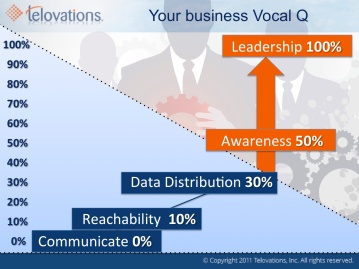Used effectively, the VocalQ℠ framework is a strategic differentiator and delivers considerable benefits. Speech recognition and analysis has come along way in the last decade and the technology is poised to accelerate in the next. The day is not too far off when speech recognition and analytics will morph from improving customer interactions to being the customer interaction. Our goal with VocalQ℠is to help companies realize the benefits:
Reduced Costs – Companies gain valuable insight into the inefficiencies of their operations. Speech analytics help to decrease call times by training agents to be more effective in harvesting information from customers. Currently, many businesses measure quantitative call data like; how many calls were received, how many calls were abandoned, how many rings it takes to answer an inbound call, etc. This data only answers “what” communication is happening within your business. VocalQ℠ measures the context and content of your communications.
Better Customer Retention – Cash spent on retaining customers through improving customer service is far less than that needed to gain a new customer. In addition to measuring quantitative and descriptive data, VocalQ℠ goes a step further by recording and alerting on the quality of interactions. With VocalQ℠,  calls are sampled with call recording and the dialog is benchmarked. Things like customers having to repeat themselves and correct responses to questions can be measured. Furthermore, the recorded conversations can be compared against customer surveys so supervisors can discover why an interaction went well or went awry.
calls are sampled with call recording and the dialog is benchmarked. Things like customers having to repeat themselves and correct responses to questions can be measured. Furthermore, the recorded conversations can be compared against customer surveys so supervisors can discover why an interaction went well or went awry.
Cross Selling – Speech Analytics identify opportunities to increase sales conversion rates, both for new customers and up-sell and cross-sell opportunities.
Reduced Risks – Using speech analytics enables a business to quickly identify potential regulatory failures or locate poorly performing agents. Rather than relying on gut feeling, you “hear” the voice of the customer, analyze the interaction in real-time, and make better strategic decisions about your company. The ability to take immediate action on “voice alerts” is another benefit of VocalQ℠. Supervisors can identify critical words and phrases in conversations and receive real-time alerts to remedy the situation now rather than later.
What other benefits have you experienced with the New VocalQ℠?

 u can sort through to get the information you need, but what if your CEO asks you for this data in a meeting with your peers? What if they need the information by tomorrow for a meeting with that client?
u can sort through to get the information you need, but what if your CEO asks you for this data in a meeting with your peers? What if they need the information by tomorrow for a meeting with that client?